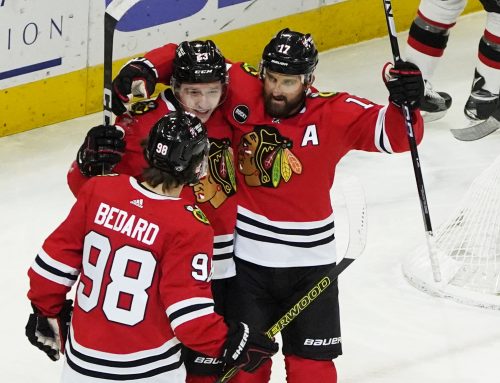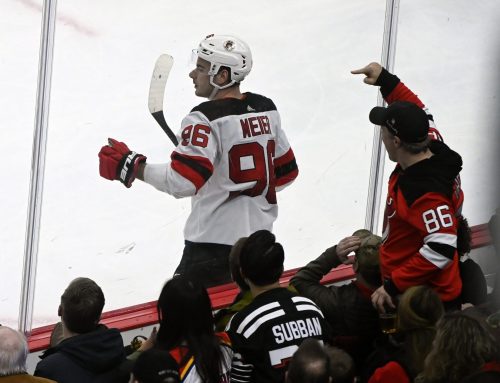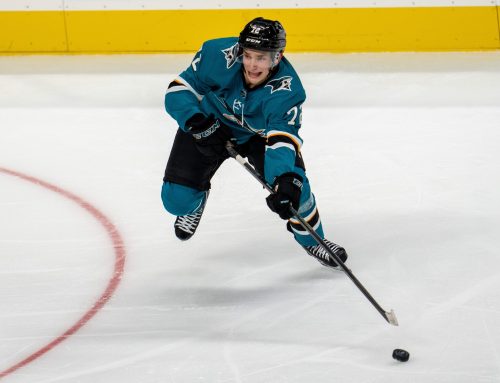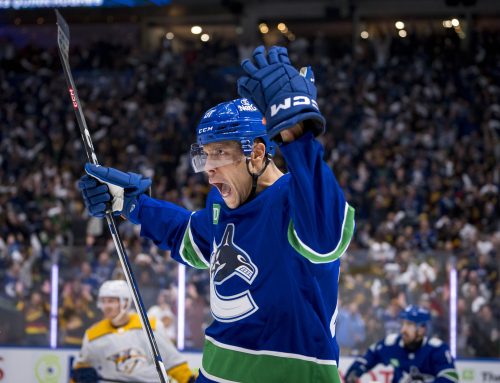Ramblings: How to Compare Players, Picks & Prospects (Aug 28)
Alexander MacLean
2022-08-28
We focused yesterday on draft strategies, players with low ADPs, and some thoughts on position scarcity for the upcoming year. Today the focus shifts to the deeper keepers/dynasty leagues, and what those groups are focusing on in the summer instead.
How to Value Players in a Trade
Many of the questions we see in the forums, article comments, or elsewhere on the internet through the summer are related to which keeper should I pick, and should I trade X & Y for Z to upgrade my keepers.
There's a short answer and a long answer to this. The short answer is that 99% of the time, the side getting the better player in the trade is "winning" the trade (i.e. going to come out of the trade in a better position than they were before compared to the other team).
The long answer is more nuanced, but comes to generally the same conclusion. The purpose of fantasy sports is to build a better team than your competitors. That means having better players, and having those players produce better results at the necessary times. The better the players compared to your opponent(s), the better the odds are of them producing better results (not having to be lucky). If you play fantasy spots, you generally understand this concept already, but it needs to be stated to properly outline these next few thoughts.
Whether your league has you owning 10 players in a six-person league, or 30 players plus a 30-player farm system in a 32-person league, that above concept of the better players remains the same. The points are the same, the theory is the same, and the better team wins more than half the time. The problem that people have, and what makes fantasy spots so much fun and at the same time so difficult, is determining which player and which team is "better".
Assuming we even had perfect projections for players, concepts such as position scarcity, streaming, and punting categories will vary the values of players to a great degree even within the same league. It's these nuances that can be difficult to account for, but the more factors that are accounted for when making a decision, the more often you will make the right decision.
*
Players vs Picks
Now, things get even more complicated when you're not even comparing player A to player B anymore. When it's a player versus a pick, how are you supposed to know how much to value each against the other. Well, typically leagues that have been running for a few seasons have struck a balance of approximately each round of pick is worth. Often those consensus ideals are better than anything one individual can come up with on their own. However, the groupthink of it does mean that there are often inefficiencies to exploit. Draft picks are ALWAYS more valuable the closer to the draft you are.
I wish I had some kind of formula on how to value picks vs players, but I don't. Even for a very specific league format it would be nigh-on-impossible to create. With all of the variations on fantasy leagues, it's a wonder I try to tackle the subject at all. The fun part is though, I don't have to tell you how to value the picks, I just need to tell you to sit back and watch.
All you have to do is pay attention to how your league-mates manage the picks. Often you can find GMs that throw away the picks for middling pieces, and then flip those picks to GMs that actually value a bundle of picks in exchange for a star player.
In every league the first round picks are necessary in a deal for the most valuable players, while the middle rounds get tossed around willy-nilly in exchange for all sorts of players. This is where you need to be careful spending your picks, and with what you are getting back in a return. If you're a sit-on-your-team kind of GM, then the values of picks depend on the depth of the draft that year, and your ability to research towards making solid picks each time. However, if you're like me, and whatever picks you're acquiring in one trade are likely going out in another trade a few weeks or months later, then those picks aren't worth the player they will be used to select, those picks are worth whatever you can get in return for them.
What I find though is that often in leagues picks get overvalued relative to players in-season as soon as a team is moderately out of contention. From there you can move the picks for players to help you contend, and while the picks still keep a heavy value in the offseason, there are a lot more teams willing to buy in the offseason, and you can recoup picks at that point.
In the end though, there's no one secret to success, but the goal is winning a championship, and that means at some point trading picks for players, not just moving players for picks indefinitely.
Managing Prospects
Now we get to the middle ground. You sat in the bottom half of the league for a couple years and locked up a bunch of top picks, or you at least held onto a few picks and now you have a range of prospects sitting in your minors garnering some attention.
The question is which do you trade, when is the optimal time to try to move them, and when do you hold in order to not end up with a team that has completely aged out. The thing with prospects is that they're all about potential. They get drafted based on potential, traded based on potential, and then once they finally make their NHL roster… fantasy owners are disappointed because they put up 18 points in 54 games.
The key with prospects is to sell the potential. Picks have unlimited potential, and that's why they're such versatile trading chips. Prospects have a large range in potential, but there is a bit more of an assumed potential when dealing with a prospect. That's why most managers will take the pick in the 20-30 range rather than the 19-year-old playing in juniors, who was drafted 20th overall the season before.
Those picks outside the top 15 or so see their value drop right after they're selected. Because suddenly the asset went from a draft pick with unlimited potential, to a known commodity with more certainty in it's potential, and a bunch of years away. The way to capitalize on a peak in a prospect's potential is to trade them either in the summer, where the opposing manager can get sucked into the idea that this prospect is ready to make their NHL team and possibly even shine in a top-six role, or right after a showcase outing, such as the World Juniors or the Memorial Cup. If they can shine on the brightest stage there, then they can of course be a star in the NHL very soon (spoiler alert: it won't be that soon).
The other best time to trade prospects is at the trade deadline, where managers at the bottom of the table are already looking at next year, so the wait time on prospects doesn't look as bad, and their potential starts to cloud with the realistic outlook.
One other prospect points I would like to make is that the closer a prospect is to the NHL, the better, regardless of what their perceived upside may be. A prospect about to make the NHL full-time at 23 or 24, even if he only seems to have a 50-point upside, is a lot more valuable than a 75-point upside guy that is five years away. In those five years you're waiting for the one prospect, you've cycled through five 23-year-old. Two or three may have busted and be on the waiver wire, but one is still on you NHL team putting up fantasy relevant numbers, and you were able to sell off one or two more while they had a quick hot-streak.
If you want a bit of a deeper dive into prospect evaluations, then check out Ben Gehrels' The Journey article from yesterday where he reviews the shiny new toy versus current production, and prospects a little closer to the show.
On that note, here are a few prospects that have caught my eye that look like they are due for NHL time and thus fantasy consideration (sorted in alphabetical order by team):
Mason McTavish – If you don't know McTavish's name by now then you either take the summers off from hockey, or you're in a very shallow league. He's one of the best bets for the Calder trophy this year, and he should be an excellent stat stuffer across any kind of category setup your league may have.
Nathan Smith – My dark-horse on the Calder ballot, if Smith can manage himself in the faceoff circle, he could thrive centering a top line with top 70+ point players in Clayton Keller and Nick Schmaltz.
Seth Jarvis – One of the most under-appreciated rookies from last season, Jarvis looks locked into a top-line role this season, and could improve into the 70-point range with some added power play points. Cliffy has mentioned him enough that I don't need to dive very far into him at this point.
Calen Addison – Not a guarantee to make the opening day lineup, but he brings a cheap contract and both high-end vision and offensive ability, all of which Minnesota is lacking on the back-end.
Robin Salo – Depth defenceman for the Islanders looks like he's the favourite to win a spot in camp. With a new coach maybe we see a few more goals out of the Isles this year, and he could be the number two offensive blueliner behind Noah Dobson.
Jake Sanderson – Perhaps even higher upside than Addison, and more likely to make the team this year, Sanderson has multi-category upside, and though he's not displacing Thomas Chabot, he should line up with Erik Brannstrom on a now-loaded second PP unit.
Dakota Joshua – The most underheralded of the group at the age of 26, but he finally looks set to be an NHL regular this fall. He has modest scoring upside, but also brings a ton of hits and some decent shot volume in very limited minutes. Signed for two years at close to the NHL minimum, Joshua is worth a look in cap leagues for managers that are looking to pinch pennies.
*
Find me on Twitter @alexdmaclean if you have any fantasy hockey questions or comments. See you next Wednesday!





 T.B
T.B FLA
FLA NYI
NYI CAR
CAR TOR
TOR VGK
VGK VAN
VAN EDM
EDM MIN
MIN
